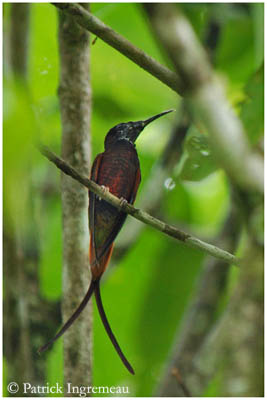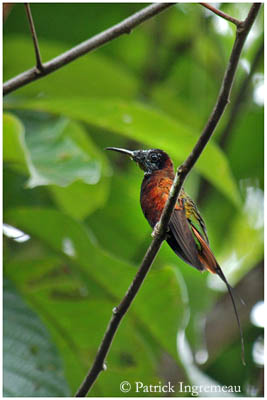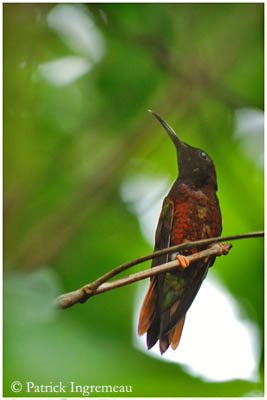
Crimson Topaz
Topaza pella
Apodiforme Order – Trochilidae Family
BIOMETRICS:
Length: M : 21-23 cm – F : 13-14 cm
Weight: M : 10-14 g – F : 10 g
DESCRIPTION:
Crimson Topaz is the largest hummingbird of Brazil. It is the second in size after the Giant Hummingbird.

Adult male is large with the bill of 4 cm, and the long tail of 12 to 13 cm length.
On the upperparts, back is glittering crimson to purple. Uppertail coverts are golden green.
On the underparts, chin and throat are bright glossy golden green, bordered by a black band. Breast and belly are iridescent orange-red. Undertail coverts are bronze-green.
Wings are brown with glossy crimson shoulders, scapulars and wing coverts.
The long tail shows bronze golden-green central rectrices and chestnut outer rectrices.
We can see two brownish median tail feathers elongated and crossed halfway down.
On the head, forehead, crown and head sides are velvet black, whereas nape and hind neck are glossy crimson to purple, as the back.
The bill is straight and black. Eyes are dark brown. Legs and feet are orange-brown.
Female is smaller (13 to 14 cm) and different in plumage. She has dark green upperparts. On the underparts, throat is green with crimson edges. The rest of underparts are green with golden-green edges. Undertail coverts are glossy green.
Tail feathers include bronze-green central rectrices, violet next pair of feathers, and chestnut outer rectrices.
Immature is similar to female. It can breed in the second year.
Crimson Topaz has four subspecies which differ in plumage colours, with more or less crimson on upperparts, and black on the head.
VOICE: SOUNDS BY XENO-CANTO
Crimson Topaz utters high-pitched chirps and whistles. Advertising calls are often short, and indicate the defence of feeding areas. Chase calls are series of rapid chattering used in territory defence.
HABITAT:
Crimson Topaz frequents the lowland rainforests up to 500 metres of elevation. It is often found in the canopy, in gallery-forest along rivers and creeks.
RANGE:
Crimson Topaz lives in Amazonian Brazil, in southern Brazil and in the Guianas.

BEHAVIOUR:
Crimson Topaz feeds on nectar in the flowered canopy of the forest. It may be seen in vines and epiphytes, visiting flowers of Bromeliaceae and Ericaceae.
According to the range, as in Surinam, it forages at low level, near the ground, taking nectar in flowering clumps and bushes.
Crimson Topaz takes flying insects caught in the air above the treetops.
The male establishes feeding territories which are defended by advertising calls and some displays. These behaviours tend to display the bright colours of the bird towards the intruders.
During breeding season, the male exposes the bright coloured throat. The iridescence of its plumage is used in several behaviours, as courtship or defence. Colours of plumage signal identity and dominance.
Crimson Topaz is mainly sedentary, but it may perform seasonal movements according to the flowering seasons in the range.
FLIGHT:
As other hummingbirds, Crimson Topaz is able to fly in all directions, performing active hovering flight at flowers when foraging. The bird remains apparently motionless in the air, but the wings move rapidly in horizontal plane, describing a flat figure of “8”.
REPRODUCTION:
Breeding season varies according to the range, but in the Guianas, Crimson Topaz breeds twice, in January-April, and again in July-November.

The nest is situated usually on small fork in branches or in vines, at about 3 to 8 metres above or near water.
The nest is cup-shaped. It is made with pale coloured plant fibres, often of Bombax seeds. These fibres are fastened with spider webs. Its size is less than half the length of the female and it appears relatively small compared to the bird.
Female lays two white eggs. Incubation lasts about 14 to 23 days (but exact time is unknown) by female.
At hatching, the chicks are black, and they have scarce pale grey down on the back. They fledge about three weeks after hatching, and they remain with the female for three weeks more.
DIET:
Crimson Topaz feeds mainly on nectar from flowers of different plants species. It also catches flying insects in the air.
PROTECTION / THREATS / STATUS:
Crimson Topaz is relatively common within its range, but it appears rare due to its secretive life hidden in treetops.
This species is not threatened at this moment.
Fr: Colibri topaze
All : Topaskolibri
Esp : Topacio Candela de Cola Canela
Ital : Colibrì topazio cremisi
Nd : Topaaskolibrie
Russe : Топазовая колибри
Port : Topazio-vermelho
Photographs by Patrick Ingremeau
TAMANDUA
Text by Nicole Bouglouan
Sources :
HANDBOOK OF THE BIRDS OF THE WORLD Vol 5 by Josep del Hoyo-Andrew Elliott-Jordi Sargatal - Lynx Edicions - ISBN: 8487334253
L’ENCYCLOPEDIE MONDIALE DES OISEAUX - Dr Christopher M. Perrins - BORDAS - ISBN: 2040185607
Arthur Grosset's Birds (Arthur Grosset)
Hummingbird Pictures Guide (Member of Fohn net)